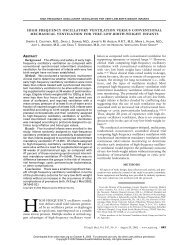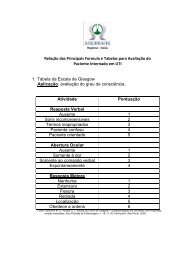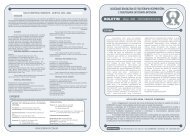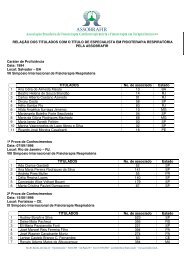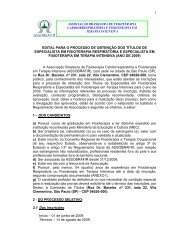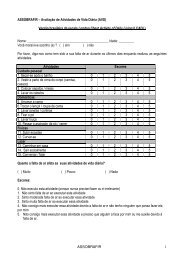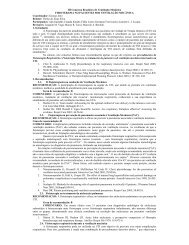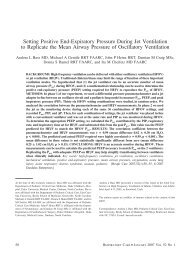Experimental models for studying mucociliary clearance - European ...
Experimental models for studying mucociliary clearance - European ...
Experimental models for studying mucociliary clearance - European ...
Create successful ePaper yourself
Turn your PDF publications into a flip-book with our unique Google optimized e-Paper software.
226M. KING25200Collection rate % mucus mg·min -12015105▲▲▲▲▲Value % control150100500▲◆024 6Exposure monthsFig. 2. – Collection rates of tracheal mucus in nine beagle dogsbe<strong>for</strong>e and after exposure to cigarette smoke <strong>for</strong> periods of 6–10months. The dogs were exposed <strong>for</strong> 5 days·week -1 to whole smokefrom 10 cigarettes·day -1 delivered via a tracheostomy tube. Themucus was collected on a cytology brush inserted through the tracheostomyand placed in contact with the posterior tracheal membrane.Each data point represents the mean of up to 16 values determinedover a 2 month interval. Each dog is represented by a different symbol.(From [55]).within 2–4 months of exposure [55]. The initial hypersecretionwas associated with decreased viscosity andelasticity, which gradually recovered towards normalduring 6–10 months of continued exposure. However,the mucin appeared to change character, assaying <strong>for</strong>considerably less neutral mucin than early in the exposureperiod.SO 2 exposure in dogs (50–200 parts per million (ppm)by tracheostomy <strong>for</strong> 3–6 months, or up to 650 ppm bynose and mouth) appears to produce similar histologicalchanges to the airway epithelium as those due to cigarettesmoke, i.e. epithelial thickening and an increasein the size of mucous glands [56, 57], and the expressionof mucous glycoprotein typical of chronic bronchitisin humans [58]. Our findings on the rheology andclearability of mucus with SO 2 exposure in dogs (fig.3) showed similarities with the response to cigarettesmoke, namely an increased quantity of less rigid, moreeasily clearable mucus [59]. The upregulation of the productionof mucus and hypersecretion of watery, moreeasily clearable mucus appears to be a natural and commonresponse to airway injury involving loss or damageto the cilia.The animal model findings have their parallels inhuman chronic bronchitis, although over a much longertime-frame of exposure. We found, <strong>for</strong> example, thatrespiratory mucus from asymptomatic smokers is betterhydrated and more easily cleared by <strong>mucociliary</strong>action than mucus from nonsmokers [60]. However, thisapparent "advantage" to smoking disappears with continuedexposure, over the course of 20–40 pack-years,and abnormalities in the elastic recoil of mucus predictiveof poor cough <strong>clearance</strong> eventually develop [61].The decrease in lung <strong>clearance</strong> due to cigarette smokinghas been well-correlated with pack-years of exposure[62].Acute exposures in dogs have been used in a varietyof situations to produce hypersecretion. Some examples8100Collection rateinclude methacholine, by infusion or aerosol, whichinduces acute hypersecretion, as well as bronchoconstriction[11, 63]. Similarly, antigen challenge, e.g. withAscaris suum cross-reactivity, can be employed [64].Human neutrophil elastase (HNE) produces an acute,intense hypersecretion, accompanied by a reduced <strong>clearance</strong>rate and an elevated viscoelasticity [65], but repeatedexposures would probably result in upregulationof natural inhibitors, such as secretory leucocyte proteaseinhibitor (SLPI), limiting the potential of this approachas a model <strong>for</strong> chronic bronchitis.Other large animal <strong>models</strong> <strong>for</strong> <strong>mucociliary</strong> functionhave been used with success. Sheep sensitized to Ascarissuum antigen show prolonged impairment of <strong>mucociliary</strong><strong>clearance</strong>, along with bronchoconstriction, andrepresent a useful model <strong>for</strong> altered airway <strong>clearance</strong> inasthma [66]. Mucociliary <strong>clearance</strong> can be studied ina variety of large animal species, including primates,cows and horses. Intraspecies differences in the rheologyand <strong>clearance</strong> of mucus have recently been reviewed byTOMKIEWICZ et al. [67]. The choice of species ultimatelydepends on which features of human chronic bronchitisone desires to emulate.ReferencesElasticityTransportabilityFig. 3. – Quantity, elasticity and ciliary transportability of trachealmucus in seven beagle dogs exposed to sulphur dioxide (SO 2 ) gasvia nose and mouth. The dogs were exposed <strong>for</strong> 2 h·day -1 , 3days·week -1 <strong>for</strong> 10–13 months. The concentration of SO 2 was increasedfrom 350 to 650 ppm over the exposure period. Tracheal mucus wascollected on a cytology brush passed through an endotracheal tubeinserted under xylazine analgesia. The elasticity of the mucus wasdetermined by magnetic rheometry, and ciliary transportability bymeans of the frog palate technique [26]. The results illustrated comparethe chronic effect, 3 days after the last exposure versus the acuteeffect, immediately after 2 h exposure to SO 2 gas during the firstmonth of the study. Values are presented as mean±SEM. : acuteexposure; : chronic exposure, i.e. 10–13 months. (From [59]).1. King M. Mucus, <strong>mucociliary</strong> <strong>clearance</strong> and coughing.In: Bates DV, ed. Respiratory Function in Disease. 3rdEdn. Philadelphia, Saunders, 1989; pp. 69–78.2. King M, Rubin BK. Rheology of airway mucus: relationshipwith <strong>clearance</strong> function. In: Takishima T, ShimuraS, eds. Airway Secretion: Physiological Bases <strong>for</strong>the Control of Mucous Hypersecretion. New York, MarcelDekker, 1994; pp. 283–314.
MODELS FOR STUDYING MUCOCILIARY CLEARANCE 2273. App EM, King M. Tracheal mucus rheology and potentialdifference in two day old puppies. Biorheology1990; 27: 515–526.4. King M. Magnetic microrheometer. In: Braga PC, AllegraL, eds. Methods in Bronchial Mucology. New York,Raven Press, 1988; pp. 73–83.5. King M. Role of mucus viscoelasticity in cough <strong>clearance</strong>.Biorheology 1987; 24: 589–597.6. Puchelle E, Zahm JM, Duvivier C. Spinnability of bronchialmucus: relationship with viscoelasticity and mucustransport properties. Biorheology 1983; 20: 239–249.7. King M, Zahm JM, Pierrot D, Vaquez-Girod S, PuchelleE. The role of mucus gel viscosity, spinnability, and adhesiveproperties in <strong>clearance</strong> by simulated cough.Biorheology 1989; 26: 737–745.8. Dasgupta B, Tomkiewicz RP, De Sanctis GT, BoydWA, King M. Rheological properties in cystic fibrosisairway secretions with combined rhDNase and gelsolintreatment. In: Singh M, Saxena VP, eds. Advances inPhysiological Fluid Dynamics. New Delhi, Narosa, 1996;pp. 74–78.9. Puchelle E, Zahm JM, Jacquot J, Plotkowski C, DuvivierC. A simple technique <strong>for</strong> measuring adhesion tensionproperties of human bronchial secretions. Eur J RespirDis 1987; 71 (Suppl. 153): 281–282.10. Tomkiewicz RP, App EM, Zayas JG, et al. Amilorideinhalation therapy in cystic fibrosis: influence on ioncontent, hydration and rheology of sputum. Am Rev RespirDis 1993; 148: 1002–1007.11. King M, Kelly S, Cosio M. Alteration of airway reactivityby mucus. Respir Physiol 1985; 62: 47–59.12. Tomkiewicz RP, App EM, De Sanctis GT, et al. A comparisonof a new mucolytic N-acetylcysteine L-lysinatewith N-acetylcysteine: airway epithelial function andmucus changes in dog. Pulm Pharmacol 1995; 8: 259–265.13. De Sanctis GT, App EM, Trask JK, et al. Resorptive<strong>clearance</strong> and transepithelial potential difference in capsaicin-treatedF344 rats. J Appl Physiol 1990; 68: 1826–1832.14. App EM, Zayas JG, King M. Rheology of mucus andepithelial potential difference: small airways vs trachea.Eur Respir J 1993; 6: 67–75.15. Festa E, Macchione M, Paiva PSO, Lorenzi G, SaldivaPHN, King M. Effects of aerosolized amiloride on <strong>mucociliary</strong>transport velocity and transepithelial potentialdifference in isolated frog palate. J Aerosol Med 1995;8: 167–176.16. King M, Phillips DM, Gross D, Vartian V, Chang HK,Zidulka A. Enhanced mucus <strong>clearance</strong> with high frequencychest wall compression. Am Rev Respir Dis1983; 128: 511–515.17. Giordano AM, Holsclaw D, Litt M. Mucus rheology and<strong>mucociliary</strong> <strong>clearance</strong>: Normal physiological state. AmRev Respir Dis 1978; 118: 245–254.18. King M. Interrelation between mechanical properties ofmucus and <strong>mucociliary</strong> transport: effect of pharmacologicinterventions. Biorheology 1979; 16: 57–68.19. King M. Relationship between mucus viscoelasticityand ciliary transport in guaran gel/frog palate <strong>models</strong>ystem. Biorheology 1980; 17: 249–254.20. Lorenzi G, Böhm GM, Guimarães ET, Costa Vaz MA,King M, Saldiva PHN. Correlation between rheologicproperties and in vitro ciliary transport of rat nasalmucus. Biorheology 1992; 29: 433–440.21. Puchelle E, Zahm JM, Polu JM. Drug effects on viscoelasticityof mucus. Eur J Respir Dis 1980; 61: 195–208.22. Shih CK, Litt M, Khan MA, Wolf DP. Effect of nondialyzablesolids concentration and viscoelasticity onciliary transport of tracheal mucus. Am Rev Respir Dis1975; 115: 989–995.23. Dulfano MJ, Adler KB. Physical properties of sputum.VII. Rheologic properties and <strong>mucociliary</strong> transport. AmRev Respir Dis 1975; 112: 341–347.24. King M, Brock G, Lundell C. Clearance of mucus bysimulated cough. J Appl Physiol 1985; 58: 1776–1782.25. Zahm JM, King M, Duvivier C, Pierrot D, Girod S,Puchelle E. Role of simulated repetitive coughing inmucus <strong>clearance</strong>. Eur Respir J 1991; 4: 311–315.26. King M, Gilboa A, Meyer FA, Silberberg A. On thetransport of mucus and its rheologic simulants in ciliatedsystems. Am Rev Respir Dis 1974; 110: 740–745.27. Rubin BK, Ramirez O, King M. The mucus depletedfrog palate as a model <strong>for</strong> the study of <strong>mucociliary</strong> <strong>clearance</strong>.J Appl Physiol 1990; 69: 424–429.28. Wills PJ, Garcia Suarez MJ, Rutman A, Wilson R, ColePJ. The ciliary transportability of sputum is slow on themucus-depleted bovine trachea. Am J Respir Crit CareMed 1995; 151: 1255–1258.29. Wills PJ, Hall RL, Chan WM, Cole PJ. Sodium chlorideincreases the ciliary transportability of cystic fibrosisand bronchiectasis sputum on the mucus-depletedbovine trachea. J Clin Invest 1997; 99: 9–13.30. King M. Measurement of <strong>mucociliary</strong> <strong>clearance</strong> usinganimal <strong>models</strong>. Excerpta Medica (Asia Pacific CongrSer) 1984; 33: 2–10.31. Festa E, Guimarães E, Macchione M, Saldiva PHN,King M. Acute effects of uridine triphosphate (UTP) on<strong>mucociliary</strong> <strong>clearance</strong> in isolated frog palate. J AerosolMed 1997; 10: 25–39.32. Festa E, Saldiva PHN, King M. Role of Exosurf on <strong>mucociliary</strong>velocity, transepithelial potential differenceand rheology in isolated frog palate. Eur Respir J 1995;8: 297s.33. Gerber V, Gehr P, Straub R, Frenz M, King M, Im HofV. Mucus quality on horse tracheal epithelium: microscopicgrading based on transparency. Respir Physiol1997; 107: 67–74.34. Kurosawa H, Wang CG, Dandurand RJ, King M, EidelmanDH. Mucociliary function in the mouse measured inexplanted lung tissue. J Appl Physiol 1995; 79: 41–46.35. Reid L. Mucus secretion and chronic bronchitis. MedThorac 1967; 24: 40–43.36. Wanner A. The role of mucus in chronic obstructivepulmonary disease. Chest 1990; 97: 11S–15S.37. Lopata M, Barton AD, Lourenço RV. Biochemical characteristicsof bronchial secretions in chronic obstructivepulmonary disease. Am Rev Respir Dis 1974; 110: 730–739.38. Goodman RM, Yergin BM, Landa JF, Golinvaux MH,Sackner MA. Relationship of smoking history and pulmonaryfunction tests to tracheal mucus velocity in nonsmokers,young smokers, exsmokers, and patients withchronic bronchitis. Am Rev Respir Dis 1978; 117: 205–214.39. Reid L. An experimental study of hypersecretion ofmucus in the bronchial tree. Br J Exp Pathol 1963; 44:437–445.40. Lamb D, Reid L. Mitotic rates, goblet cell increase andhistochemical changes in mucus in rat bronchial epitheliumduring exposure to sulfur dioxide. J Pathol Bacteriol1968; 96: 97–111.41. Lamb D, Reid L. Goblet cell increase in rat bronchialepithelium after exposure to cigarette and cigar tobaccosmoke. Br Med J 1969; 1: 33–35.42. Hayaski M, Sornberger CG, Huber GL. Morphometricanalyses of tracheal gland secretion and hypertrophy in
228M. KINGmale and female rats after experimental exposure totobacco smoke. Am Rev Respir Dis 1979; 119: 67–73.43. King M, Angus E. Influence of tobacco smoke on trachealmucus in rats (Abstract). Fed Proc 1980; 39: 36.44. Harkema JR, Hotchkiss JA. In vivo effects of endotoxinon intraepithelial mucosubstances in rat pulmonaryairways: quantitative histochemistry. Am J Pathol 1992;141: 307–317.45. Saldiva PHN, King M, Delmonte VLC, et al. Respiratoryalterations due to urban air pollution: an experimentalstudy in rats. Environ Res 1992; 57: 19–33.46. Lemos M, Lichtenfels AJFC, Amaro E Jr, et al. Quantitativepathology of nasal passages in rats exposed tourban levels of air pollution. Environ Res 1994; 66:87–95.47. Pon DJ, van Staden CJ, Boulet L, Rodger IW. Hyperplasticeffects of aerosolized sodium metabisulfite onrat airway mucus-secretory epithelial cells. Can J PhysiolPharmacol 1994; 72: 1025–1030.48. Adler KB, Fischer BM, Li H, Choe NH, Wright DT.Hypersecretion of mucin in response to inflammatorymediators by guinea-pig tracheal epithelial cells in vitrois blocked by inhibition of nitric oxide synthase. Am JRespir Cell Mol Biol 1995; 13: 526–530.49. Hulbert WC, Walker DC, Jackson A, Hogg JC. Airwaypermeability to horseradish peroxidase in guinea-pigs:the repair phase after injury by cigarette smoke. Am RevRespir Dis 1981; 123: 320–326.50. De Sanctis GT, Rubin BK, Ramirez O, King M. Ferrettracheal mucus rheology, clearability and volume followingadministration of substance P or methacholine.Eur Respir J 1993; 6: 76–82.51. Schuster A, Ueki I, Nadel JA. Neutrophil elastase stimulatestracheal submucosal gland secretion that is inhibitedby ICI 200,355. Am J Physiol 1992; 262: L86–L91.52. Auerbach O, Hammond ED, Kirman D, Garfinkel L,Stout AP. Histologic changes in bronchial tubes of cigarette-smokingdogs. Cancer 1967; 20: 2055–2066.53. Park SS, Kikkawa Y, Goldring IP, et al. An animalmodel of cigarette smoking in beagle dogs. Am RevRespir Dis 1977; 115: 971–979.54. Wanner A, Hirsch JA, Greeneltch DE. Tracheal mucousvelocity in beagles after chronic exposure to cigarettesmoke. Arch Environ Health 1973; 27: 370–371.55. King M, Wight A, De Sanctis GT, et al. Mucus hypersecretionand viscoelasticity changes in cigarette-smokingdogs. Exp Lung Res 1989; 15: 375–389.56. Angus E, Amyot R, Martin R. Morphological changesin beagle dogs following exposures to SO 2 . Clin Res1976; 24: 689A.57. Scanlon PD, Seltzer J, Ingram RH Jr, Reid L, DrazenJM. Chronic exposure to sulfur dioxide: physiologic andhistologic evaluation of dogs exposed to 50 or 15 ppm.Am Rev Respir Dis 1987; 135: 831–839.58. Bhaskar KR, Drazen JM, O'Sullivan DD, Scanlon PM,Reid LM. Transition from normal to hypersecretorybronchial mucus in a canine model of bronchitis: changesin yield and composition. Exp Lung Res 1988; 14:101–120.59. King M, Boileau R, Delaunois L, Martin RR. Alterationin tracheal mucus viscoelasticity with chronicsulfur dioxide exposure (Abstract). Am Rev Respir Dis1980; 121(2): 243.60. Rubin BK, Ramirez O, Zayas JG, Finegan B, King M.Respiratory mucus from asymptomatic smokers is betterhydrated and more easily cleared by <strong>mucociliary</strong>action. Am Rev Respir Dis 1992; 145: 545–547.61. Zayas JG, Man GCW, King M. Tracheal mucus rheologyin patients undergoing diagnostic bronchoscopy:interrelations with smoking and cancer. Am Rev RespirDis 1990; 141: 1107–1113.62. Vastag E, Matthys H, Zsamboki G, Köhler D, DaikelerG. Mucociliary <strong>clearance</strong> in smokers. Eur J Respir Dis1986; 68: 107–113.63. King M, Viires N. Effect of methacholine chloride onrheology and transport of canine tracheal mucus. J ApplPhysiol: Respirat Environ Exercise Physiol 1979; 47:26–31.64. King M, El-Azab J, Phillips DM, Angus GE. Antigenchallenge and canine tracheal mucus. Int Arch AllergyAppl Immunol 1985; 77: 337–342.65. King M, Tomkiewicz RP, App EM, Dasgupta B, BoydWA. Effects of human neutrophil elastase (HNE) and recombinantsecretory leukocyte protease inhibitor (SLPI)on airway epithelial function in dogs in vivo. Am JRespir Crit Care Med 1995; 151: A529.66. Allegra L, Abraham WM, Chapman GA, Wanner A.Duration of <strong>mucociliary</strong> dysfunction following antigenchallenge. J Appl Physiol: Respirat Environ ExercisePhysiol 1983; 55: 726–730.67. Tomkiewicz RP, Albers GM, De Sanctis GT, RamirezOE, King M, Rubin BK. Species differences in thephysical and transport properties of airway secretions.Can J Physiol Pharmacol 1995; 73: 165–171.



